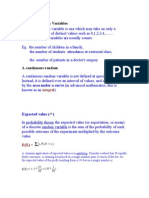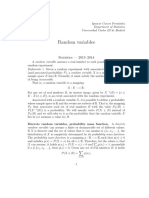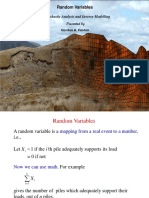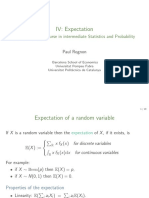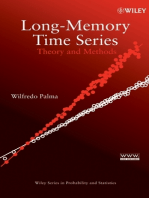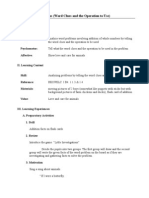0 ratings0% found this document useful (0 votes)
8 viewsLecture 2
mat stat
Uploaded by
katrineenghoffCopyright
© © All Rights Reserved
Available Formats
Download as PDF, TXT or read online on Scribd
0 ratings0% found this document useful (0 votes)
8 viewsLecture 2
mat stat
Uploaded by
katrineenghoffCopyright
© © All Rights Reserved
Available Formats
Download as PDF, TXT or read online on Scribd
You are on page 1/ 17
ST521: Mathematical Statistics
Random variables Part I
Jing Qin
ST521 (IMADA) Mathematical Statistics: Lecture 2 1 / 12
Outline
1 General definition
2 Discrete random variables
ST521 (IMADA) Mathematical Statistics: Lecture 2 2 / 12
(+) Random variable and distribution function
(Def +) A random variable is a function X : Ω → R with the
property that {ω|X (ω) ≤ x} ∈ F for each x ∈ R. Such function is
said to be F-measurable.
(Def 4.1+) The distribution function of a random variable X is the
function F : R → [0, 1] given by
FX (x) = P(X ≤ x).
Example: (Exp 2.14)
Flip a (balanced) coin twice, we could consider the following:
1 Ω = {HH, HT , TH, TT }, F =? and P(A) =?
2 X := the number of heads observed.
3 X ({HH}) = 2, X ({HT }) = X ({TH}) = 1 and X ({TT }) = 0.
4 Question: what is the distribution function of the random variable
X ? Draw a diagram with x values as x-axis and F (x) in y-axis.
ST521 (IMADA) Mathematical Statistics: Lecture 2 3 / 12
Categories of distributions
(Def 2.12+) A random variable X is discrete if its range contains
only at most countable values in R. (Exp 2.14)
(Def 4.2) A random variable X is continuous if its distribution
function is continuous. E.g. throw an arrow on the floor. Consider
its angle when landing.
(+) There can be random variables that are a mixture between
discrete and continuous random variables. E.g. Toss a coin+throw
arrow depending on the coin result.
ST521 (IMADA) Mathematical Statistics: Lecture 2 4 / 12
Outline
1 General definition
2 Discrete random variables
ST521 (IMADA) Mathematical Statistics: Lecture 2 5 / 12
Probability (mass) function p(y )
(Def 3.2) Probability (mass) function of a r.v. Y is the following
p(y ) := P(Y = y ) =sum of the probabilities of sample points that
are assigned value y .
P
(Thm 3.1) 0 ≤ p(y ) ≤ 1 and y p(y ) = 1.
(Revisit) Example: (Exp 2.14)
Flip a (balanced) coin twice (first time, second time), we could
consider the following:
1 Ω = {HH, HT , TH, TT };
2 X := the number of heads observed.
3 X ({HH}) = 2, X ({HT }) = X ({TH}) = 1 and X ({TT }) = 0.
4 Exercise: Calculate p(2), p(1) and p(0).
ST521 (IMADA) Mathematical Statistics: Lecture 2 6 / 12
Expectation of r.v.
Given pY (y ) = P(Y = y ).
P P
(Def 3.4) If y |y | · pY (y ) < ∞, then E(Y ) = y y · pY (y ) is called
the expectation/expected value/mean of the r.v. Y . It tells the
“central value" of Y .
(Thm 3.2) Let g(Y ) be a real-valued function of Y and pY (y ) be
the probability function of Y . Then the expected value E(g(Y ))
has the following property
X
E[g(Y )] = g(yj ) · pY (yj ).
yj
This tells us to calculate E(g(Y )), we only need to know pY
instead of pg(Y ) .
Proof.
ST521 (IMADA) Mathematical Statistics: Lecture 2 7 / 12
Variance of r.v.
(Def 3.5) If Y is a r.v. with E(Y ) = µ. The variance of Y is defined
to be
V (Y ) = E[(Y − µ)2 ].
Informally, it measures how far (Euclidean distance) the values of
Y spread away from µ.
Sometimes using notation σ 2 .
The standard deviation of Y is the positive square root of V (Y ).
Example: Calculate µ and σ 2 for the following r.v. Y :
y 0 1 2 3
p(y ) 1/8 1/4 3/8 1/4
µ = 1.75 and σ 2 = .9375
ST521 (IMADA) Mathematical Statistics: Lecture 2 8 / 12
Variance of r.v.
(Def 3.5) If Y is a r.v. with E(Y ) = µ. The variance of Y is defined
to be
V (Y ) = E[(Y − µ)2 ].
Informally, it measures how far (Euclidean distance) the values of
Y spread away from µ.
Sometimes using notation σ 2 .
The standard deviation of Y is the positive square root of V (Y ).
Example: Calculate µ and σ 2 for the following r.v. Y :
y 0 1 2 3
p(y ) 1/8 1/4 3/8 1/4
µ = 1.75 and σ 2 = .9375
ST521 (IMADA) Mathematical Statistics: Lecture 2 8 / 12
Properties of E(Y )
Let Y be a random variable in the following.
(Thm 3.3) Let c be a constant, then E(c) = c.
Proof.
ST521 (IMADA) Mathematical Statistics: Lecture 2 9 / 12
Properties of E(Y )
Let Y be a random variable in the following.
(Thm 3.3) Let c be a constant, then E(c) = c.
Proof.
ST521 (IMADA) Mathematical Statistics: Lecture 2 9 / 12
Properties of E(Y )
(Thm 3.4) Let g(Y ) be a function of Y and c is a constant, then
E[c · g(Y )] = c · E[g(Y )].
Proof.
ST521 (IMADA) Mathematical Statistics: Lecture 2 10 / 12
Properties of E(Y )
(Thm 3.4) Let g(Y ) be a function of Y and c is a constant, then
E[c · g(Y )] = c · E[g(Y )].
Proof.
ST521 (IMADA) Mathematical Statistics: Lecture 2 10 / 12
Linearity of E(Y )
(Thm 3.5) Let g1 (Y ), g2 (Y ) be functions of Y , then
E[g1 (Y ) + g2 (Y )] = E[g1 (Y )] + E[g2 (Y )].
Proof.
Thm 3.4+3.5 can give rise to the linearity of E(Y ). Let
g1 (Y ), g2 (Y ), . . . , gk (Y ) be functions of Y and c1 , c2 , . . . , ck be
some constants. Then we have
" k # k
X X
E ci · gi (Y ) = ci · E[gi (Y )].
i=1 i=1
Later
Pnwe will seePanother result Thm (5.12),
E( i=1 ai Yi ) = ni=1 ai · E(Yi ) within multi-variate probability
distribution.
ST521 (IMADA) Mathematical Statistics: Lecture 2 11 / 12
Linearity of E(Y )
(Thm 3.5) Let g1 (Y ), g2 (Y ) be functions of Y , then
E[g1 (Y ) + g2 (Y )] = E[g1 (Y )] + E[g2 (Y )].
Proof.
Thm 3.4+3.5 can give rise to the linearity of E(Y ). Let
g1 (Y ), g2 (Y ), . . . , gk (Y ) be functions of Y and c1 , c2 , . . . , ck be
some constants. Then we have
" k # k
X X
E ci · gi (Y ) = ci · E[gi (Y )].
i=1 i=1
Later
Pnwe will seePanother result Thm (5.12),
E( i=1 ai Yi ) = ni=1 ai · E(Yi ) within multi-variate probability
distribution.
ST521 (IMADA) Mathematical Statistics: Lecture 2 11 / 12
Application: Property of V (Y )
(Thm 3.6) Let E(Y ) = µ, then
V [Y ] = E[Y 2 ] − (E(Y ))2 = E[Y 2 ] − µ2 .
We also have V (Y ) = E[Y (Y − 1)] + E(Y ) − [E(Y )]2 (Useful in
the next lecture).
Proof.
ST521 (IMADA) Mathematical Statistics: Lecture 2 12 / 12
Application: Property of V (Y )
(Thm 3.6) Let E(Y ) = µ, then
V [Y ] = E[Y 2 ] − (E(Y ))2 = E[Y 2 ] − µ2 .
We also have V (Y ) = E[Y (Y − 1)] + E(Y ) − [E(Y )]2 (Useful in
the next lecture).
Proof.
ST521 (IMADA) Mathematical Statistics: Lecture 2 12 / 12
You might also like
- Distributions and Normal Random VariablesNo ratings yetDistributions and Normal Random Variables8 pages
- Introductory Probability and The Central Limit TheoremNo ratings yetIntroductory Probability and The Central Limit Theorem11 pages
- Random Variables and Probability DistributionsNo ratings yetRandom Variables and Probability Distributions15 pages
- Random Variables: Presented by in Stochastic Analysis and Inverse Modelling100% (1)Random Variables: Presented by in Stochastic Analysis and Inverse Modelling21 pages
- AE 248: AI and Data Science: Prabhu Ramachandran 2024-01-01No ratings yetAE 248: AI and Data Science: Prabhu Ramachandran 2024-01-0112 pages
- Probability and Statistics: B Madhav Reddy Madhav.b@srmap - Edu.inNo ratings yetProbability and Statistics: B Madhav Reddy Madhav.b@srmap - Edu.in17 pages
- Stats Revision Slides (From Maria Molina-Domene)No ratings yetStats Revision Slides (From Maria Molina-Domene)32 pages
- Variance of Discrete Random Variables Class 5, 18.05 Jeremy Orloff and Jonathan Bloom 1 Learning GoalsNo ratings yetVariance of Discrete Random Variables Class 5, 18.05 Jeremy Orloff and Jonathan Bloom 1 Learning Goals7 pages
- Lesson 2: Some Elements of Probability Theory and StatisticsNo ratings yetLesson 2: Some Elements of Probability Theory and Statistics14 pages
- 2.1 Random Variables 2.1.1 Definition: PX PX X100% (1)2.1 Random Variables 2.1.1 Definition: PX PX X13 pages
- 3. Random Variables and Distribution FunctionsNo ratings yet3. Random Variables and Distribution Functions33 pages
- EE311_Lecture_Chapter_#04_Random_Variables_and_ExpectationNo ratings yetEE311_Lecture_Chapter_#04_Random_Variables_and_Expectation48 pages
- Random Variables and Applications: OPRE 6301No ratings yetRandom Variables and Applications: OPRE 630135 pages
- Mathematics 1St First Order Linear Differential Equations 2Nd Second Order Linear Differential Equations Laplace Fourier Bessel MathematicsFrom EverandMathematics 1St First Order Linear Differential Equations 2Nd Second Order Linear Differential Equations Laplace Fourier Bessel MathematicsNo ratings yet
- Activity 1: K-W-L Chart What I Know What I Want To Know What I LearnedNo ratings yetActivity 1: K-W-L Chart What I Know What I Want To Know What I Learned5 pages
- Eagle Quantum Premier 8 Channel Relay Module Model EQ3720RM: Specification DataNo ratings yetEagle Quantum Premier 8 Channel Relay Module Model EQ3720RM: Specification Data4 pages
- Analyzing Word Problems (Word Clues and The Operation To Use)No ratings yetAnalyzing Word Problems (Word Clues and The Operation To Use)5 pages
- Oblique Shock Wave - Mechanical Engineering DepartmentNo ratings yetOblique Shock Wave - Mechanical Engineering Department9 pages
- The Rotordynamics Analysis of The Washing Machine Shaft Supported by Passive MagneticNo ratings yetThe Rotordynamics Analysis of The Washing Machine Shaft Supported by Passive Magnetic22 pages
- Job Safety Environmental Analysis Pre-Task BriefingNo ratings yetJob Safety Environmental Analysis Pre-Task Briefing5 pages
- Unit 3: Capacity Requirement Planning (CRP)No ratings yetUnit 3: Capacity Requirement Planning (CRP)25 pages
- Lesson Plan For Grade 3 English (Aiza A. Miranda-Bse3-2E)No ratings yetLesson Plan For Grade 3 English (Aiza A. Miranda-Bse3-2E)10 pages
- AE2 Speaking Midterm April.2022 - Topic and InstructionsNo ratings yetAE2 Speaking Midterm April.2022 - Topic and Instructions1 page
- Call for Papers_BSA_Vienna_2025_Bourdieu_finaleNo ratings yetCall for Papers_BSA_Vienna_2025_Bourdieu_finale4 pages
- Points East and West: Acupuncture and Comparative Philosophy of ScienceNo ratings yetPoints East and West: Acupuncture and Comparative Philosophy of Science10 pages
- Your Guide To Abs and Ebs: Updated September 2003No ratings yetYour Guide To Abs and Ebs: Updated September 200340 pages
- Microstation V8 2004 Edition: Pattern/Graphics IssueNo ratings yetMicrostation V8 2004 Edition: Pattern/Graphics Issue7 pages
- Introductory Probability and The Central Limit TheoremIntroductory Probability and The Central Limit Theorem
- Random Variables: Presented by in Stochastic Analysis and Inverse ModellingRandom Variables: Presented by in Stochastic Analysis and Inverse Modelling
- AE 248: AI and Data Science: Prabhu Ramachandran 2024-01-01AE 248: AI and Data Science: Prabhu Ramachandran 2024-01-01
- Probability and Statistics: B Madhav Reddy Madhav.b@srmap - Edu.inProbability and Statistics: B Madhav Reddy Madhav.b@srmap - Edu.in
- Variance of Discrete Random Variables Class 5, 18.05 Jeremy Orloff and Jonathan Bloom 1 Learning GoalsVariance of Discrete Random Variables Class 5, 18.05 Jeremy Orloff and Jonathan Bloom 1 Learning Goals
- Lesson 2: Some Elements of Probability Theory and StatisticsLesson 2: Some Elements of Probability Theory and Statistics
- EE311_Lecture_Chapter_#04_Random_Variables_and_ExpectationEE311_Lecture_Chapter_#04_Random_Variables_and_Expectation
- Computer Solved: Nonlinear Differential EquationsFrom EverandComputer Solved: Nonlinear Differential Equations
- Mathematics 1St First Order Linear Differential Equations 2Nd Second Order Linear Differential Equations Laplace Fourier Bessel MathematicsFrom EverandMathematics 1St First Order Linear Differential Equations 2Nd Second Order Linear Differential Equations Laplace Fourier Bessel Mathematics
- Activity 1: K-W-L Chart What I Know What I Want To Know What I LearnedActivity 1: K-W-L Chart What I Know What I Want To Know What I Learned
- Eagle Quantum Premier 8 Channel Relay Module Model EQ3720RM: Specification DataEagle Quantum Premier 8 Channel Relay Module Model EQ3720RM: Specification Data
- Analyzing Word Problems (Word Clues and The Operation To Use)Analyzing Word Problems (Word Clues and The Operation To Use)
- Oblique Shock Wave - Mechanical Engineering DepartmentOblique Shock Wave - Mechanical Engineering Department
- The Rotordynamics Analysis of The Washing Machine Shaft Supported by Passive MagneticThe Rotordynamics Analysis of The Washing Machine Shaft Supported by Passive Magnetic
- Job Safety Environmental Analysis Pre-Task BriefingJob Safety Environmental Analysis Pre-Task Briefing
- Lesson Plan For Grade 3 English (Aiza A. Miranda-Bse3-2E)Lesson Plan For Grade 3 English (Aiza A. Miranda-Bse3-2E)
- AE2 Speaking Midterm April.2022 - Topic and InstructionsAE2 Speaking Midterm April.2022 - Topic and Instructions
- Points East and West: Acupuncture and Comparative Philosophy of SciencePoints East and West: Acupuncture and Comparative Philosophy of Science
- Microstation V8 2004 Edition: Pattern/Graphics IssueMicrostation V8 2004 Edition: Pattern/Graphics Issue


